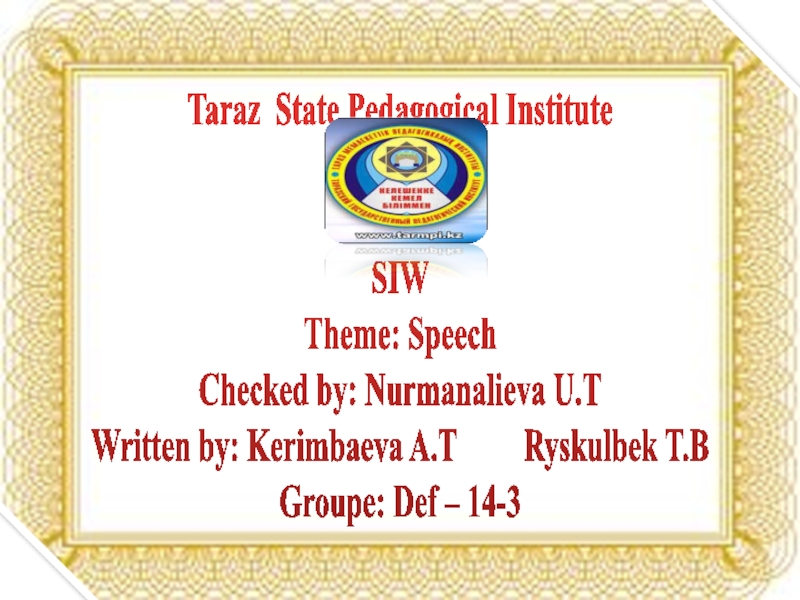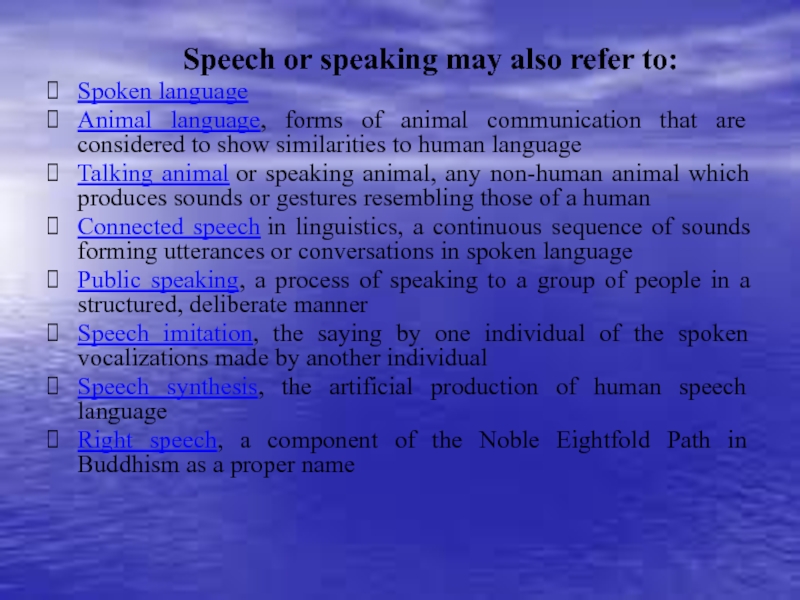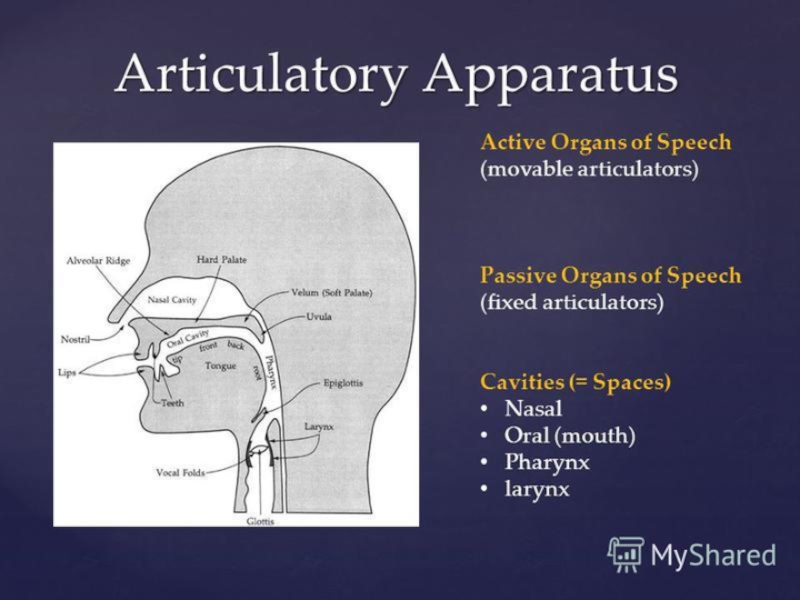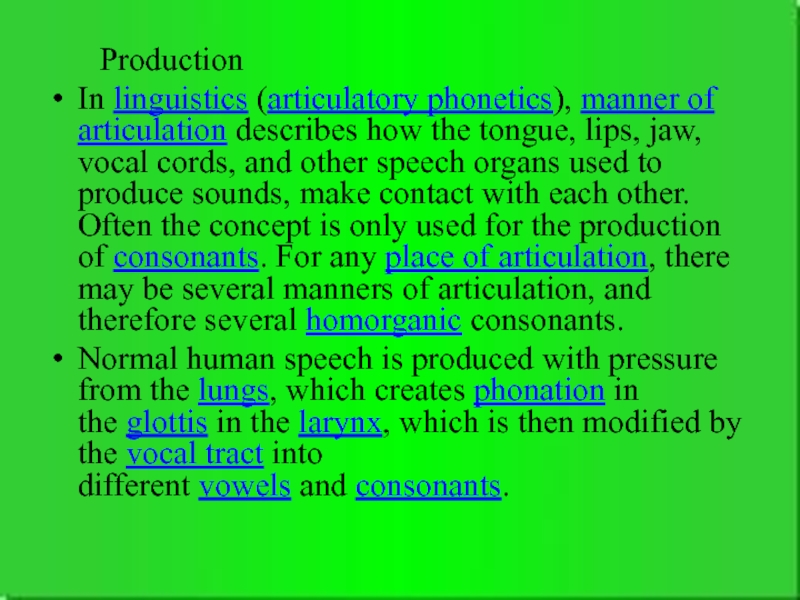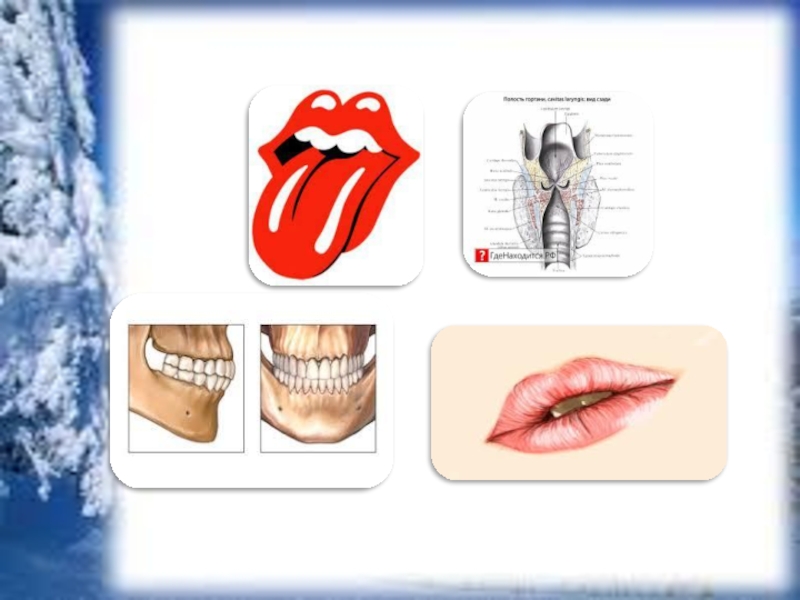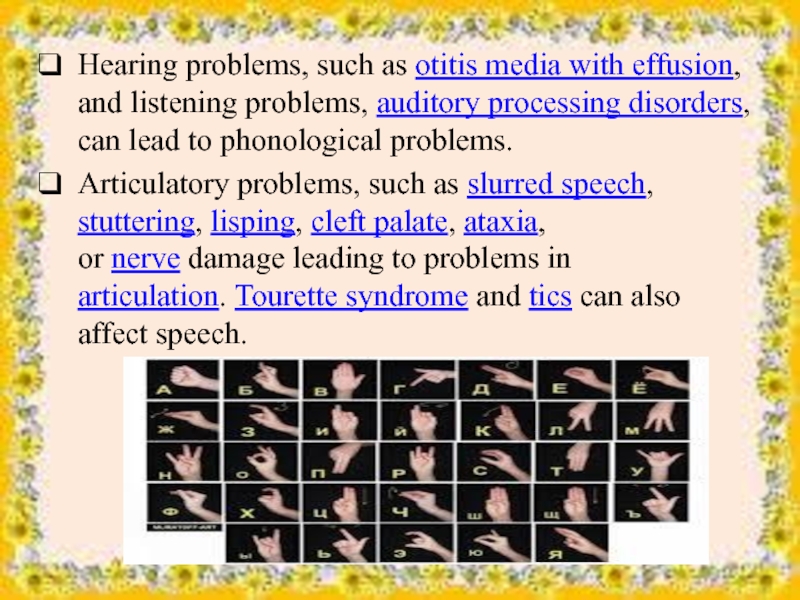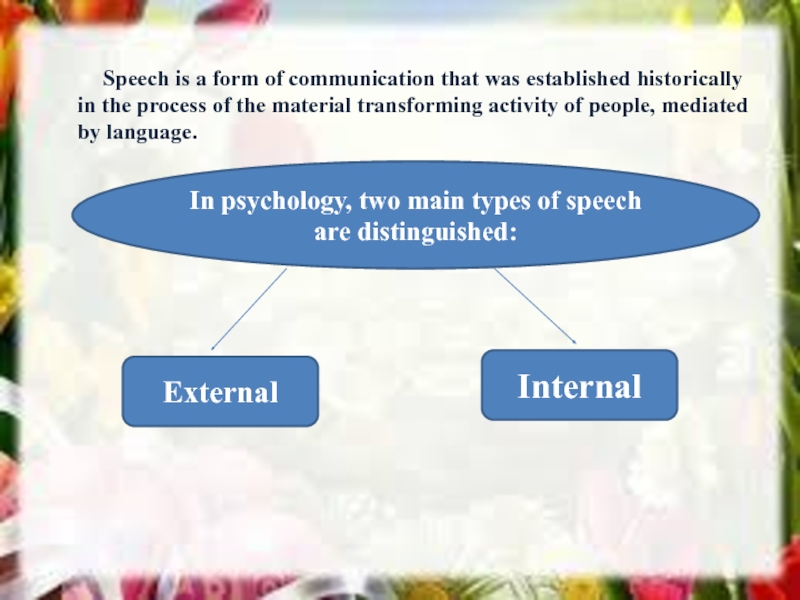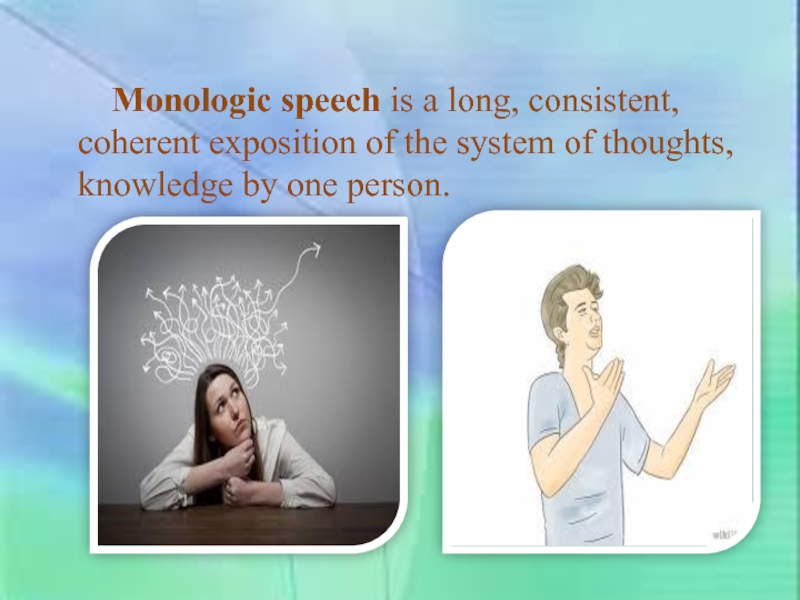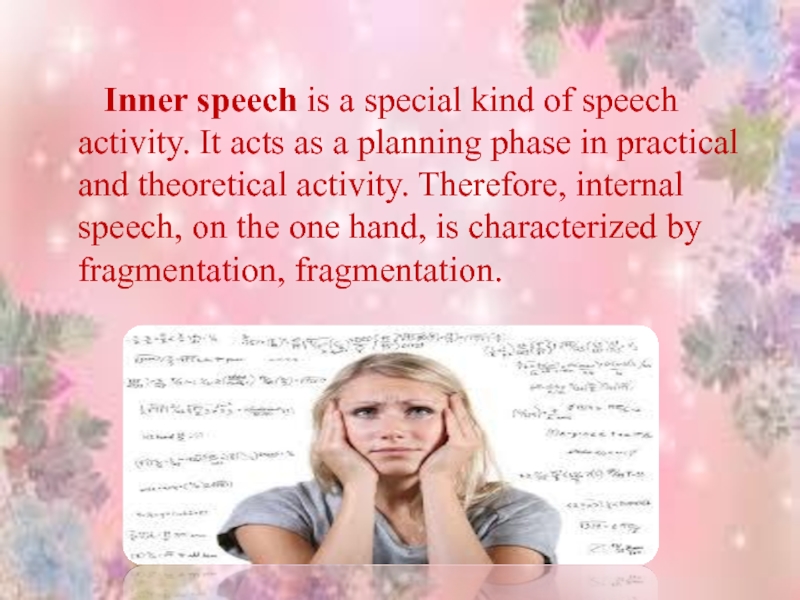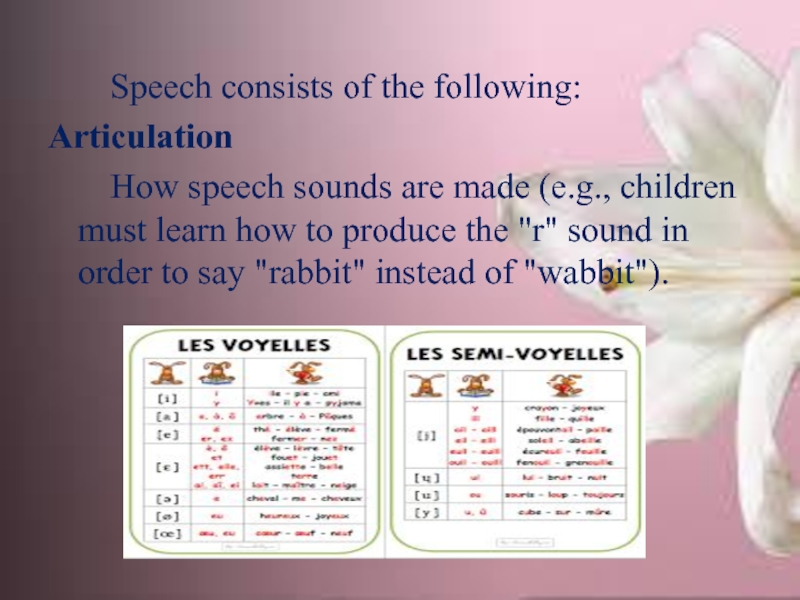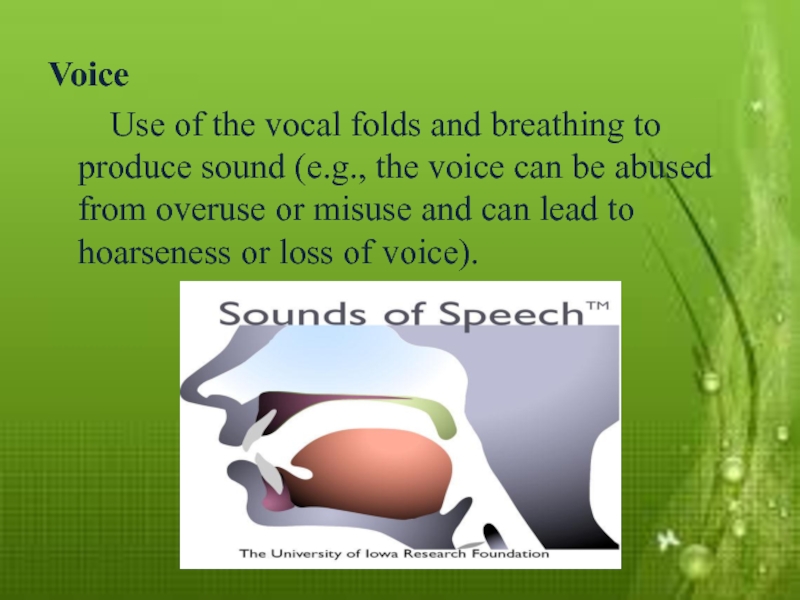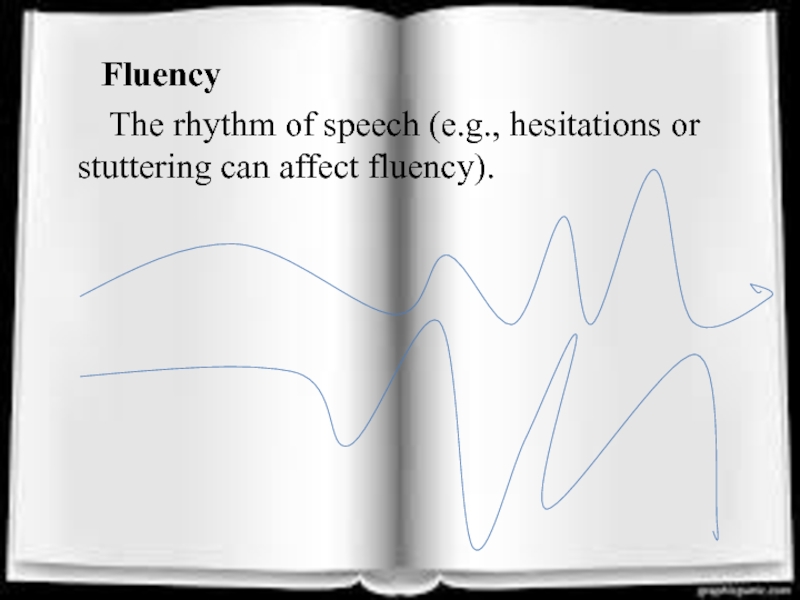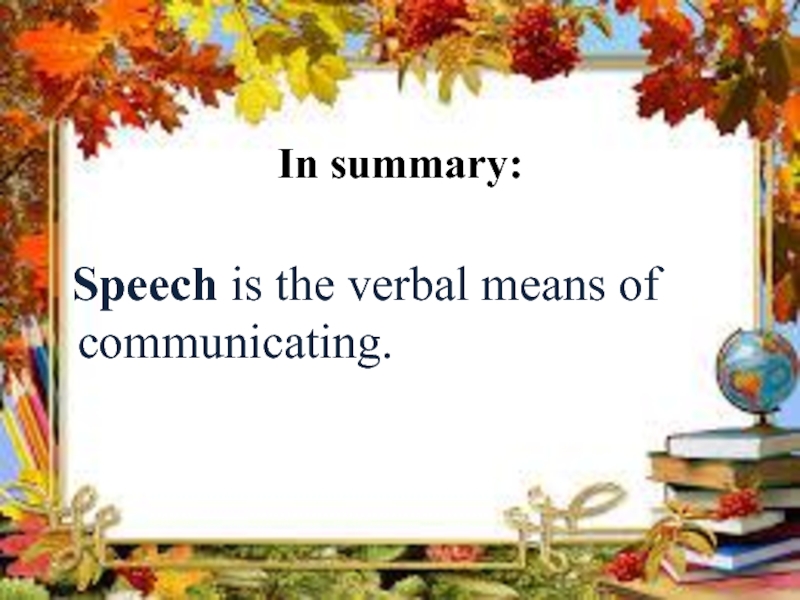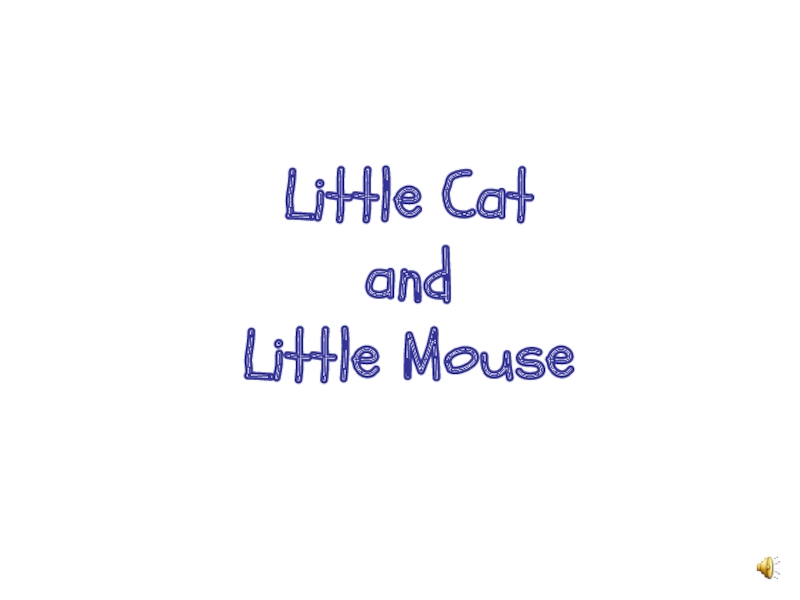Ryskulbek T.B
Groupe: Def – 14-3
- Главная
- Разное
- Дизайн
- Бизнес и предпринимательство
- Аналитика
- Образование
- Развлечения
- Красота и здоровье
- Финансы
- Государство
- Путешествия
- Спорт
- Недвижимость
- Армия
- Графика
- Культурология
- Еда и кулинария
- Лингвистика
- Английский язык
- Астрономия
- Алгебра
- Биология
- География
- Детские презентации
- Информатика
- История
- Литература
- Маркетинг
- Математика
- Медицина
- Менеджмент
- Музыка
- МХК
- Немецкий язык
- ОБЖ
- Обществознание
- Окружающий мир
- Педагогика
- Русский язык
- Технология
- Физика
- Философия
- Химия
- Шаблоны, картинки для презентаций
- Экология
- Экономика
- Юриспруденция
Language and speech. Types of speech презентация
Содержание
- 1. Language and speech. Types of speech
- 2. Lesson plan: Language and speech; Types of speech
- 3. Speech is the vocal form of human communication.
- 6. Production In linguistics (articulatory phonetics), manner
- 9. Hearing problems, such as otitis media with effusion,
- 10. Paul Broca Two areas of the cerebral
- 11. Speech is
- 12. External speech includes
- 13. Monologic speech is
- 14. Written speech is
- 15. Inner speech is
- 16. Speech consists of
- 17. Voice Use of
- 18. Fluency
- 19. In summary: Speech is the verbal means of communicating.
- 20. Thank you for your attention!
Слайд 1Taraz State Pedagogical Institute SIW Theme: Speech Checked by: Nurmanalieva U.T Written by: Kerimbaeva A.T
Слайд 4
Speech or speaking may also refer to:
Spoken language
Animal language, forms of animal communication that are considered to show similarities to human language
Talking animal or speaking animal, any non-human animal which produces sounds or gestures resembling those of a human
Connected speech in linguistics, a continuous sequence of sounds forming utterances or conversations in spoken language
Public speaking, a process of speaking to a group of people in a structured, deliberate manner
Speech imitation, the saying by one individual of the spoken vocalizations made by another individual
Speech synthesis, the artificial production of human speech language
Right speech, a component of the Noble Eightfold Path in Buddhism as a proper name
Spoken language
Animal language, forms of animal communication that are considered to show similarities to human language
Talking animal or speaking animal, any non-human animal which produces sounds or gestures resembling those of a human
Connected speech in linguistics, a continuous sequence of sounds forming utterances or conversations in spoken language
Public speaking, a process of speaking to a group of people in a structured, deliberate manner
Speech imitation, the saying by one individual of the spoken vocalizations made by another individual
Speech synthesis, the artificial production of human speech language
Right speech, a component of the Noble Eightfold Path in Buddhism as a proper name
Слайд 6 Production
In linguistics (articulatory phonetics), manner of articulation describes how the tongue,
lips, jaw, vocal cords, and other speech organs used to produce sounds, make contact with each other. Often the concept is only used for the production of consonants. For any place of articulation, there may be several manners of articulation, and therefore several homorganic consonants.
Normal human speech is produced with pressure from the lungs, which creates phonation in the glottis in the larynx, which is then modified by the vocal tract into different vowels and consonants.
Normal human speech is produced with pressure from the lungs, which creates phonation in the glottis in the larynx, which is then modified by the vocal tract into different vowels and consonants.
Слайд 8
Problems involving speech
There are several organic and psychological factors that can affect speech. Among these are:
Diseases and disorders of the lungs or the vocal cords, including paralysis, respiratory infections (bronchitis), vocal fold nodules and cancers of the lungs and throat.
Diseases and disorders of the brain, including alogia, aphasias, dysarthria, dystonia and speech processing disorders, where impaired motor planning, nerve transmission, phonological processing or perception of the message (as opposed to the actual sound) leads to poor speech production.
There are several organic and psychological factors that can affect speech. Among these are:
Diseases and disorders of the lungs or the vocal cords, including paralysis, respiratory infections (bronchitis), vocal fold nodules and cancers of the lungs and throat.
Diseases and disorders of the brain, including alogia, aphasias, dysarthria, dystonia and speech processing disorders, where impaired motor planning, nerve transmission, phonological processing or perception of the message (as opposed to the actual sound) leads to poor speech production.
Слайд 9Hearing problems, such as otitis media with effusion, and listening problems, auditory processing
disorders, can lead to phonological problems.
Articulatory problems, such as slurred speech, stuttering, lisping, cleft palate, ataxia, or nerve damage leading to problems in articulation. Tourette syndrome and tics can also affect speech.
Articulatory problems, such as slurred speech, stuttering, lisping, cleft palate, ataxia, or nerve damage leading to problems in articulation. Tourette syndrome and tics can also affect speech.
Слайд 10Paul Broca
Two areas of the cerebral cortex are necessary for speech.
Broca's area, named after its discoverer, French neurologist Paul Broca (1824-1880), is in the frontal lobe, usually on the left, near the motor cortex controlling muscles of the lips, jaws, soft palate and vocal cords. When damaged by a stroke or injury, comprehension is unaffected but speech is slow and labored, and the sufferer will talk in "telegramese".
Слайд 11 Speech is a form of communication
that was established historically in the process of the material transforming activity of people, mediated by language.
In psychology, two main types of speech are distinguished:
External
Internal
Слайд 12 External speech includes oral (dialogical and monologic)
and written. Dialogue is the direct communication of two or more people. Dialogue speech is a supported speech; The interlocutor puts in the course of her clarifying questions, giving cues, can help finish the idea (or reorient it).
Слайд 13 Monologic speech is a long, consistent, coherent
exposition of the system of thoughts, knowledge by one person.
Слайд 14 Written speech is a kind of monologic
speech. It is more developed than oral monologic speech.
Слайд 15 Inner speech is a special kind of
speech activity. It acts as a planning phase in practical and theoretical activity. Therefore, internal speech, on the one hand, is characterized by fragmentation, fragmentation.
Слайд 16 Speech consists of the following:
Articulation
How speech sounds are made (e.g., children must learn how to produce the "r" sound in order to say "rabbit" instead of "wabbit").
Слайд 17Voice
Use of the vocal folds and breathing
to produce sound (e.g., the voice can be abused from overuse or misuse and can lead to hoarseness or loss of voice).
